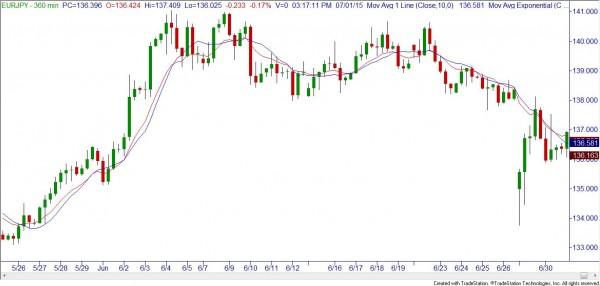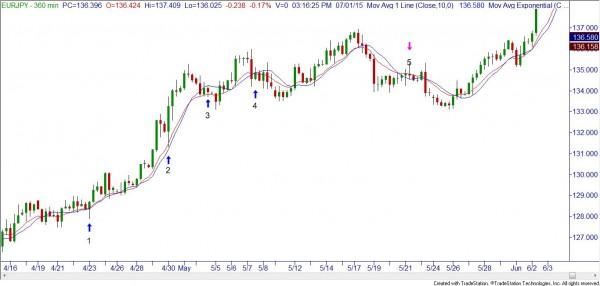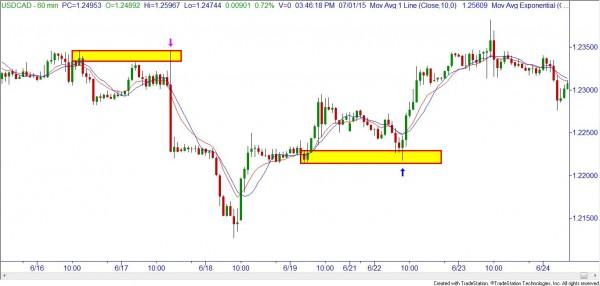![]()
Hello traders! This week’s newsletter finds me taking a couple more weeks off; so home in Dallas, Texas until the second week in July. So far, no 100 degree days for us! I’ll take it. But the real purpose of this newsletter is to not talk about our (so far!) mild summer, but to explore one of the most popular technical analysis techniques, the moving average. We’ll first explore what they are, then how some traders use them and, finally, how I personally use them. On with the show!
First of all, what is a moving average? On this chart, I have attached two moving averages, one blue and one red. The blue line is what we call the 10 period, simple moving average. To perform the calculations to get the moving average (MA for short), usually you would take the last 10 (in a 10 period, no kidding) closing prices of the candles, add the numbers up and divide by ten. When the next latest candle closes, you would get rid of the oldest candle’s closing data point and use the newest candle, so you still have 10; add them up, divide by ten and get the latest average data point. So on and so on. Using this formula is commonly called a “simple moving average.” Now, the computer is kind enough to not only plot the data points for us, but to “connect the dots” of all those data points-which gives us the “moving” part of the average.
Now, what about the other line, the red one? That is what we call an “exponential” moving average, where more emphasis is put on the more recent data than the old data. There are a couple of ways to do the math but for brevity’s sake I’ll let you go on the internet to find the math. Bottom line, the exponential MA follows the current price more closely than the simple MA. When price turns lower, you can see the red line turns before the blue does; when prices go higher, the red line turns higher before the blue.
So far we’ve just defined the extreme basics of what MA’s are. Now, how do many traders use them? I believe that MA’s are one of the more misused analysis techniques that exist – I’ll show a couple examples of those common mistakes. The first mistake is buying the currency pair every time it moves down to an upward trending moving average, or selling the pair every time price moves up to a downward sloping moving average.
As you can see, the idea of buying at the pullbacks to the blue arrows makes sense-but where would your stops go? On most of the trades marked, if your stop was just on the other side of the moving average you would have been stopped out on nearly every trade-except trade #2! There are two problems with the entry at blue arrow number 2; the first is that you had to be very quick to get into the trade as there was nothing else indicating a good place to buy. The other problem is you are buying after the price has already been moving up for days!
So, the commonly used techniques are to use the MA’s for direction (long when trending up, short when trending down), and to enter at or on the MA. On a cynical note, if this technique is so awesome, why aren’t there many more traders making tons and tons of pips? Well, because they aren’t using supply and demand to enter their trades. Let’s break down how I prefer to use MA’s.
While the techniques mentioned above can certainly help when used properly with supply and demand zones, one idea that I’ll throw at you this week is to trade in the opposite direction to the MA’s. I say this because the “A” stands for average and very often a fast move away from the average is followed by a fast move back to the average-a reversion to the mean type of trade (yes, Bollinger Bands can be used in a similar way). At the pink arrow we have a supply zone that was quickly tested and as price moved up, high and far away from the MA, a potential sell order could be placed.
At the blue arrow a nice demand zone was retested, with price under the moving average-indicating prices were CHEAPER than average. Kind of like being on sale! Not a bad place to take a long trade.
Another way that I recommend using the MAs is to let your winners run when taking trades in the direction of longer term MAs (which ones? See you in class!) When going against a longer term trend I am quicker to take profits. When trading with the longer term trend I prefer to set my reward to risk ratios to more like 5:1 or higher.
So there you have it. A brief definition of what moving averages are, a common way to trade them that doesn’t work and a couple more that hopefully will help you pull in more pips.
This content is intended to provide educational information only. This information should not be construed as individual or customized legal, tax, financial or investment services. As each individual's situation is unique, a qualified professional should be consulted before making legal, tax, financial and investment decisions. The educational information provided in this article does not comprise any course or a part of any course that may be used as an educational credit for any certification purpose and will not prepare any User to be accredited for any licenses in any industry and will not prepare any User to get a job. Reproduced by permission from OTAcademy.com click here for Terms of Use: https://www.otacademy.com/about/terms
Editors’ Picks
EUR/USD clings to gains above 1.0750 after US data

EUR/USD manages to hold in positive territory above 1.0750 despite retreating from the fresh multi-week high it set above 1.0800 earlier in the day. The US Dollar struggles to find demand following the weaker-than-expected NFP data.
GBP/USD declines below 1.2550 following NFP-inspired upsurge

GBP/USD struggles to preserve its bullish momentum and trades below 1.2550 in the American session. Earlier in the day, the disappointing April jobs report from the US triggered a USD selloff and allowed the pair to reach multi-week highs above 1.2600.
Gold struggles to hold above $2,300 despite falling US yields

Gold stays on the back foot below $2,300 in the American session on Friday. The benchmark 10-year US Treasury bond yield stays in negative territory below 4.6% after weak US data but the improving risk mood doesn't allow XAU/USD to gain traction.
Bitcoin Weekly Forecast: Should you buy BTC here? Premium

Bitcoin (BTC) price shows signs of a potential reversal but lacks confirmation, which has divided the investor community into two – those who are buying the dips and those who are expecting a further correction.
Week ahead – BoE and RBA decisions headline a calm week

Bank of England meets on Thursday, unlikely to signal rate cuts. Reserve Bank of Australia could maintain a higher-for-longer stance. Elsewhere, Bank of Japan releases summary of opinions.
RECOMMENDED LESSONS
Making money in forex is easy if you know how the bankers trade!
Discover how to make money in forex is easy if you know how the bankers trade!
5 Forex News Events You Need To Know
In the fast moving world of currency markets, it is extremely important for new traders to know the list of important forex news...
Top 10 Chart Patterns Every Trader Should Know
Chart patterns are one of the most effective trading tools for a trader. They are pure price-action, and form on the basis of underlying buying and...
7 Ways to Avoid Forex Scams
The forex industry is recently seeing more and more scams. Here are 7 ways to avoid losing your money in such scams: Forex scams are becoming frequent. Michael Greenberg reports on luxurious expenses, including a submarine bought from the money taken from forex traders. Here’s another report of a forex fraud. So, how can we avoid falling in such forex scams?
What Are the 10 Fatal Mistakes Traders Make
Trading is exciting. Trading is hard. Trading is extremely hard. Some say that it takes more than 10,000 hours to master. Others believe that trading is the way to quick riches. They might be both wrong. What is important to know that no matter how experienced you are, mistakes will be part of the trading process.



